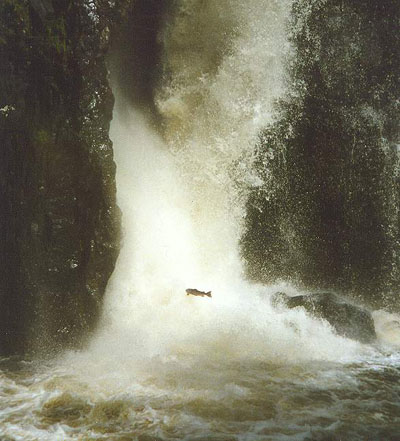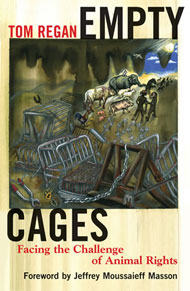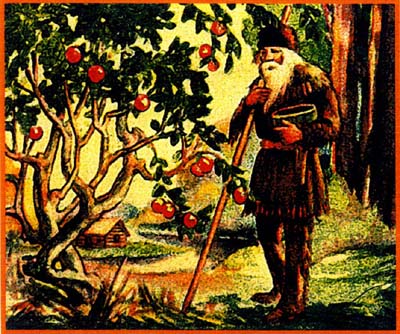Guest Editorial: How About Fish?
by Richard Schwartz

Jewish vegetarians argue that Jews should eliminate, or at least sharply reduce, their consumption of animal products because the realities of animal-based diets and agriculture are sharply inconsistent with basic Jewish mandates to take care of our health, treat animals with compassion, preserve the environment, conserve resources, share with hungry people, and seek and pursue peace. These principles apply to all who seek to lead a responsible and moral life.
However, many people who abstain from eating mammals and birds continue to eat fish, sometimes arguing that problems associated with the production and consumption of other animal products do not apply to fish. After all, they reason, fish are not raised under extremely cruel, confined conditions on factory farms; unlike the raising of livestock, fishing does not cause the erosion and depletion of soil, require the destruction of forests to create pastureland and land to grow feed crops, and require huge amounts of pesticides and irrigation water. Also, fish is generally lower in fat than other animal products, and is often erroneously considered a healthy food.
Let us consider vegetarian arguments as they apply to the "production" and consumption of fish:
1. Compassion for animals
Too often we tend to class fish with plants rather than with animals. Yet, unlike edible plants, fish are vertebrate animals with highly developed nervous systems. Dr. Donald Bloom, professor of animal welfare at Cambridge University, reminds us that "the scientific literature is quite clear. Anatomically, physiologically, and biologically, the pain system in fish is virtually the same as in birds and mammals." Fishing is not painless for fish by any means. When fish are hauled up from the deep, the sudden change in pressure on their bodies causes painful decompression which often leads their gills to collapse and their eyes to pop out. As soon as fish are removed from the water, they begin to suffocate. Hooked fish struggle because of physical pain and fear. As Dr. Tom Hopkins, professor of marine science at the University of Alabama describes it, getting hooked on a line is "like dentistry without novocain, drilling into exposed areas."
Fish that are "farmed," as opposed to caught, do not have an easier existence. Most trout, catfish, and many other species eaten in the United States are raised in modern "fish factories," where they are subject to the same intensive, crowded conditions as land farm animals. Modern aquaculture trends involve large-scale, highly mechanized fish production, much like the chicken industry. Like crowded broiler chickens, fish are crammed in enormous pools called "raceways," where they are pushed to gain weight far faster than is natural in order to maximize profits. Under these very crowded, unnatural conditions, fish suffer from stress, infections, parasites, oxygen depletion, and gas bubble disease, akin to "the bends" in human beings. To prevent the spread of diseases among the fish, large amounts of antibiotics are used.
It's also worthwhile to point out that fish are not the only animals to suffer because of people's appetite for their flesh. Egrets, hawks, and other birds who eat fish are often shot or poisoned to prevent them from eating fish at large open pools where fish are raised. In one documented case, a California company with a U. S. Fish and Wildlife permit to shoot 50 birds annually in the late 1980s was estimated to kill 10,000 to 15,000 birds, including many species not listed on the permit. Also many non-target animals, including sea turtles, dolphins, sea birds, and other fish, die horribly in commercial fishing nets.
2. Human Health
Fish is often considered a healthy food. However, while fish is generally lower in fat than other animal products, it has no fiber and virtually no complex carbohydrates or vitamin C, contains excessive amounts of protein and none of the protective phytochemicals and antioxidants found only in foods of plant origin. The average American consumes far more protein than required, and much less fiber than is necessary. The overconsumption of protein (especially from animals) has been linked to several health problems, including kidney stones and osteoporosis, while the lack of fiber appears to contribute to diverticulosis and colon cancer. Also, not all fish are low in fat; salmon, for example, has 52 percent of its calories as fat.
Fish does possess the heart-protective omega-3 fatty acid EPA, but this is made by both fish and humans from the essential omega-3 fatty acid ALA, which can be obtained from many plant foods, including green leafy vegetables, flaxseed, canola, soybean, and walnut oils, tofu, pumpkin, and wheat germ. These plant foods generally come without the nutritional hazards of fish. Further, fish oil tends to be unstable and easily becomes dangerously rancid, as the "fishy" smell of decay around fish markets testifies.
The greatest health hazard from eating fish, however, comes from the depradations we humans have caused in their natural environment. Fish and shellfish are repositories for the industrial and municipal wastes and agricultural chemicals flushed into the world's waters.
Consider PCBs, a synthetic liquid once widely used for industrial purposes. A six-month investigation by Consumers Union (publishers of Consumer Reports magazine), concluded: "By far the biggest source of PCBs in the human diet is fish.... As PCBs linger in the environment, their composition changes, and they gradually become more toxic...these more toxic forms are likely to be found in fish.... PCBs accumulate in body tissue. The PCBs that you eat today will be with you decades into the future." Consumers Union found PCBs in 43 percent of the salmon, 25 percent of the swordfish, and 50 percent of the lake whitefish they checked.
Other pollutants that concentrate in sea creatures include pesticides; toxic metals including lead, mercury, cadmium, chromium, and arsenic; dioxins; and radioactive substances such as strontium 90. Because of biological magnification during movement up the food chain, these pollutants can reach levels as much as 9 million times that of the water in which the fish live, and they have been linked to many health problems, including impaired behavioral development in young children. Nursing infants consume half of their mother's load of PCBs, dioxin, DDT, and other deadly toxins.
Consumers Union's tests also showed that nearly half the fish tested from markets in New York City, Chicago, and Santa Cruz, CA, were contaminated by bacteria from human or animal feces. In addition, fish often are loaded with disease-causing worms and parasites. Many of the diseases fish harbor can only be treated in humans with antibiotics. However, because of the way fish are raised - in crowded conditions on "aquatic" farms - fish factories give these same antibiotics to the fish to preserve their "crop." Increasing numbers of bacteria are becoming resistant to the drugs, making the treatment of some diseases more difficult in humans.
3. Environmental Impacts
If we aren't worried about the impact eating fish will have on our own health, we should be concerned about the impact fishing has on the earth's health. Modern commercial fishing uses vast "factory" trawlers the size of football fields, with huge nets sometimes miles long that swallow up everything in their path. The result is that thirteen of the world's seventeen major fisheries are depleted or in serious decline, and the other four are considered "over exploited" or "fully exploited."
The World Conservation Union lists over 1,000 fish worldwide as endangered or threatened.. As with the tropical rain forests, today we are effectively "clear cutting" diverse underwater environments with our appetite for fish. Some waters that were once teeming with life are now so barren they have been compared to a "dust bowl."
Depleted fisheries have ripple effects throughout the entire marine ecosystem. Major predator-prey situations have been changed. For example, a decline in pollock in western Alaska has caused a 90 percent decline in Steller sea lions which caused the National Marine Fisheries Service to give them the designation of "threatened" in 1990 and "endangered" in 1997. Loss of sea lions deprived killer whales of their primary source of nutrition, and they have shifted to eating sea otters. As a result, sea otters have also declined by 90 percent since 1990, resulting in a surge by their prey, sea urchins. The ecological principle that "everything is connected to everything else" is dramatically illustrated here.
The environmental impact of aquatic farming is also cause for concern. First, wild stocks are displaced as introduced fish invade spawning grounds and compete for food. Interbreeding pollutes the genetic pool. A study of forty extinct fish species by the National Fisheries Research Centre in the U. S. indicated that species introduced at aquatic farms helped wipe out 68 percent of the indigenous species. Interbreeding from genetically modified fish that escape into the open ocean also threatens disaster in some areas.
Second, fish farming depletes natural resources. Modern commercial fishing is extremely energy intensive. It requires as much as twenty calories of fossil fuel energy to produce one calorie of food energy from fish. Production of fish food is fifty to one hundred times as energy intensive as production of plant food, even when the plant foods are produced with modern technology.
Moreover, where fish are grown in artificial ponds, vast amounts of water are required as the medium of growth, to replenish oxygen, and to remove wastes from the aquatic system. Raising a ton of fish on an aquatic farm requires 8 tons of water, almost the 8.5 tons of water needed to raise a ton of grain-fed beef. This great need for water has caused further environmental destruction too, as aquaculture is routinely conducted on coastal land cleared of mangrove forests, the prime breeding and spawning ground for many fish. To date, about half the world's mangrove forests have been cleared, drained, or filled to make room for fish farms.
4. Seeking and Pursuing Peace
The Jewish sages, commenting on the fact that the Hebrew words for bread and war come from the same root, stated that shortages of grain and other resources makes war more likely. [George Fox makes similar observations about desire as the root of violence.] The truth of their words is illustrated by the increasing battles over increasingly scarce fish in many areas. A United Nations official describes the situation on the high seas as "the emerging anarchy in the oceans." With so many vessels scouring increasingly fished-out waters, squabbles and confrontations are expanding. Russians have attacked Japanese vessels in the Northwest Pacific. Scottish fishers have attacked a Russian trawler. A Falkland Islands' patrol chased a Taiwanese squid boat more than 4,000 miles. Norwegian patrols cut the nets of three Icelandic ships in the Arctic, and exchanged shots. The UN reported a 10 percent escalation in piracy and armed robberies directed toward ships, many of them fishing vessels.
In summary, the "production" and consumption of fish is harmful to human health, causes great suffering to the fish, threatens the ocean's biodiversity, wastes resources, and makes national conflicts more likely. Hence, an end to, or at least a sharp decline in, the consumption of fish and other animal products is a societal imperative and arguably a moral imperative for Jews and other people of faith.
Richard Schwartz, a leader of the Jewish vegetarian movement, was our pilgrim in the May issue. This essay comes from his web site.


 The book begins with a narrated scene of horror: a beautiful white cat with
no name is skinned alive and then boiled alive by a cook in a Chinese village.
This account made me so distraught and sickened that I wanted to stop
reading and forget if I could. But I plunged on, and got more bad news:
this sort of thing does not happen only in exotic locales; horrors equally
great, or even worse, are known to take place right here in the USA to pigs,
cows, turkeys and chickens. The people responsible for these operations
swear and declare that they are committed to "humane" treatment and the
"welfare" of the animals. Just as in the "Newspeak" of Oceania in George
Orwell's 1984, "humane" and "welfare" actually mean their opposites. More
disturbingly, we learn that the big businessmen of the animal business go to
great lengths, even hiring provocateurs to attack their own facilities in
order to discredit their opponents, all the while presenting themselves as
the "moderate" victims of "terrorism." And the media, all too often, parrot
what they have to say.
The book begins with a narrated scene of horror: a beautiful white cat with
no name is skinned alive and then boiled alive by a cook in a Chinese village.
This account made me so distraught and sickened that I wanted to stop
reading and forget if I could. But I plunged on, and got more bad news:
this sort of thing does not happen only in exotic locales; horrors equally
great, or even worse, are known to take place right here in the USA to pigs,
cows, turkeys and chickens. The people responsible for these operations
swear and declare that they are committed to "humane" treatment and the
"welfare" of the animals. Just as in the "Newspeak" of Oceania in George
Orwell's 1984, "humane" and "welfare" actually mean their opposites. More
disturbingly, we learn that the big businessmen of the animal business go to
great lengths, even hiring provocateurs to attack their own facilities in
order to discredit their opponents, all the while presenting themselves as
the "moderate" victims of "terrorism." And the media, all too often, parrot
what they have to say. My path into vegetarianism has been remarkably unspectacular. In my high school there were a few vegetarian students, and I thought I might try vegetarianism myself. I wasn't particularly motivated by the usual arguments--health, animal cruelty, and the environment. Rather, these just seemed to be added bonuses. My family, for the most part, had gone vegetarian, and seeing some of my friends try it as well just made it feel like a natural course of events in my life. Once I had made the decision and stopped eating flesh, I didn't experience any strong withdrawal or regret. I fell into the habit rather easily.
My path into vegetarianism has been remarkably unspectacular. In my high school there were a few vegetarian students, and I thought I might try vegetarianism myself. I wasn't particularly motivated by the usual arguments--health, animal cruelty, and the environment. Rather, these just seemed to be added bonuses. My family, for the most part, had gone vegetarian, and seeing some of my friends try it as well just made it feel like a natural course of events in my life. Once I had made the decision and stopped eating flesh, I didn't experience any strong withdrawal or regret. I fell into the habit rather easily. Felix Salten (1869-1945) is the Austrian Jewish writer of many novels, but
is best known as the author of Bambi, published in 1926 and banned ten
years later by the Third Reich--not just because of the author's ethnicity,
but also because its anti-hunting message was offensive to (inconsistent)
National-Socialist ideology. Though his books were burned in bonfires, the
author himself escaped to Switzerland.
Felix Salten (1869-1945) is the Austrian Jewish writer of many novels, but
is best known as the author of Bambi, published in 1926 and banned ten
years later by the Third Reich--not just because of the author's ethnicity,
but also because its anti-hunting message was offensive to (inconsistent)
National-Socialist ideology. Though his books were burned in bonfires, the
author himself escaped to Switzerland. The one who made Bambi a household word in the United States is of course
Walter Elias Disney (1901-1966), the great Irish-American filmmaker who
created one classic movie masterpiece after another, including what has been
so far the one and only screen adaptation of Salten's magnum opus. Disney
transformed Bambi and his family from European Roe deer to American White
Tails, and softened the rough edges of a rather gritty story, but the
central anti-hunting message was, if anything, strengthened. Unfortunately,
when the movie came out in 1942 Mr. Salten did not get a pfennig from it, as
he had sold the rights in 1933.
The one who made Bambi a household word in the United States is of course
Walter Elias Disney (1901-1966), the great Irish-American filmmaker who
created one classic movie masterpiece after another, including what has been
so far the one and only screen adaptation of Salten's magnum opus. Disney
transformed Bambi and his family from European Roe deer to American White
Tails, and softened the rough edges of a rather gritty story, but the
central anti-hunting message was, if anything, strengthened. Unfortunately,
when the movie came out in 1942 Mr. Salten did not get a pfennig from it, as
he had sold the rights in 1933.
 . . . . A boy
. . . . A boy